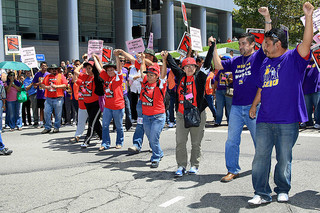The Supreme Court this week dealt a blow to the nation's struggling labor unions. In a 5-4 decision along partisan lines, the court ruled that some government workers who decline membership in the unions that represent them can't be forced to pay collective bargaining fees.
Just over 11 percent of the U.S. workforce belongs to a union today, the lowest rate in more than 70 years.
That's a far cry from the boom in organized labor that began during World War II with a surge in manufacturing and industrial growth. By 1945, more than 26 percent of the nation's civilian wage and salary workers were members of unions, nearly quadruple the rate from the previous decade. The spike led to higher wages in a range of industries, fueling America's burgeoning middle class. Through the 1950s and '60s membership rates continued to climb, reaching a peak of nearly 27 percent by 1953, according the Bureau of Labor Statistics. (The BLS differentiates the rate of union membership from that of union representation, which is always slightly higher; by the mid-1950s roughly 35 percent of workers were represented by unions.)
But as the economy sputtered in the 1970s, these rates began to steadily decline. Much of this drop has occurred in the private sector, where fewer than 7 percent of workers now belong to unions, the BLS reports. That's less than five times the public sector's membership rate, which still hovers above 35 percent. But that too has been on the wane, and is likely to decline further as a result of the court's decision.
